Hoping to find traces of the fishing village that was Edo (present-day Tokyo) before the first Tokugawa Shogun chose the site for his new political capital in the early 1600s, I head to Gyoranzaka (Fish-basket Slope) in the city's central Mita district.
I don't expect the piscine pizzazz of Tsukiji fish market, but on exiting Shirokane Takanawa Station on the Toei Mita subway line I find nothing more fishy than a peacock — a Daimaru Peacock supermarket, to be precise. Surely it has filets for sale, but as that's not exactly what I'd had in mind, I plod onward to scale the slope.
Gyoranzaka is hardly steep, but it's broiling out, and soon I feel like a fish out of water. I take refuge in the shade of a thick-trunked cherry tree in the precincts of Daishin-ji Temple. Like many others nearby, Daishin-ji, which dates from 1611, was relocated here in 1635 from Hatchobori (in present-day Chuo Ward) to make room for Edo infrastructure improvements.
Strolling about, I discover an abundantly fruiting jujube tree (Ziziphus zizyphus) and a stone disk commemorating Genzaemon Ishimura, Edo's first shamisen craftsman. His remains rest here in the temple, along with those of 11 generations of his family.
Practically next door, red gates lead to Gyoran-ji, a temple that might hold clues to the area's history. My attention is diverted, however, by the building next door. Two small arrows form a charming slide handle to the entrance of Hasegawa Kyuguten. I enter a room lined with yūmi, the long bows used in kyūdō (Japanese archery). Featuring an asymmetrical grip two-thirds down the length, and a typical height of more than 2 meters, the recurved bows are fiercely elegant.
I walk in on an impromptu lesson being given by the shop's reigning doyenne, Toshiko Hasegawa, to a customer who has come in for pointers on his tenouchi (bow-holding technique). Diminutive but powerful, 82-year-old Hasegawa minces no words critiquing his form, yet he hangs on her every syllable, the picture of respect.
Meanwhile, I glance around at the complicated accoutrements of kyūdō: colorful nigirikawa (deerskin grips) dyed in Edo-komon patterns, hemp bowstrings in coils, and giriko konaire (resin-holders) made from hollowed-out deer antlers. When Hasegawa finishes her tutorial, she tells me that her 60-year-old son, Eiichi, is a third-generation yashi (arrow-maker).
I am keen to see the workshop and eagerly follow Toshiko under a life-size carved bear's head, through the family kitchen, and into a lovely bright workspace, its windows open and sunshine falling on honeyed bamboo bows and arrows.
Eiichi is in the company of two of his apprentices. Emiko Furuya, 32, is deftly beveling long strands of Indonesian rattan to wrap around bows where the arrow rests, while Harumi Akatsuka, 46, is busy truing arrows. To do this, she passes the bamboo shafts rapidly over a flame, then applies gentle torque between the four nodes (natural growth joints) with a handmade tool called a tamegi.
"Not only must all four arrows in a set be the same weight, girth, length, pliability and balance," Eiichi says, as he shaves microns off the outer edge of an arrow, "but the nodes also need to be in the same location."
After gathering up his bamboo shavings, Eiichi next rolls out a worm of pine resin mixed with iron filings. With a fire-heated poker, he tamps in just the right amount at the notch end of each arrow to assure the weight and balance of all four arrows is exactly the same.
I sit mesmerized for several hours, long enough for my legs to ache and for Eiichi to wonder aloud just what I am hoping to see. The fletching process? "We're not doing that this week," he says, eyeing me over his glasses.
"Anyway, fletching really stinks," Harumi offers, "because the feathers are heated and attached with boiled deerskin glue and you can't get the smell out of your clothes for days."
It occurs to me that in the world of Japanese archery, deer really get the shaft, as it were. Birds don't get off easy either, I realize, as Eiichi produces a bag stuffed with hundreds of feathers, split along the rachides. "Before we attach feathers," he says with a half-grin, "we have to separate them into groups of 12, matching up the patterns. It's a puzzle."
Everyone works quietly as I play with the feathers. Occasionally the apprentices offer insights, such as the notion that archers carry both "male" and "female" arrows. Ones fletched with feathers that curl slightly toward the left, which cause them to spin clockwise in flight, are considered male and are called haya — the first of two arrows an archer shoots at the target. The arrow fletched with right-curving feathers, the otoya (second arrow), is considered female, and spins counterclockwise.
My brain is now spinning, too, and I quiver with admiration for the elegant arrows — as well as for the spirit and knowledge of Eiichi Hasegawa and his apprentices. Thinking to buy an arrow as a souvenir, I learn that a set of four shoots up from ¥10,000 all the way to ¥2 million. I settle for the joy of seeing them made, which is, of course, priceless.
Exiting the shop, I enter Gyoran-ji Temple's gates. There, at last, I find a fish, cradled like a baby in a basket, carved on the money-collection box. The temple has the dusty, brooding appearance of great age, and I ring at the priest's residence to learn more about it. His wife tells me the temple venerates a statue of the Kannon bodhisattva of mercy, the Gyoran Kanzeon Bosatsu, the 10th of Kannon's 33 incarnations.
The temple's enshrined sculpture, which is believed to be around 1,300 years old and to have come from from T'ang Dynasty China, depicts a maiden carrying a fish in a basket. The story goes that Buddha assumed the shape of a lovely young lady selling fish from a bamboo basket, and the statue was carved to celebrate this miracle.
However, the priest's wife regretfully tells me the statue is only displayed once a year, on the second Saturday in May. Instead, she shows me a golden replica, and though I snap a picture of it, I rue the fish that got away.
Back on the slope, I stop in at Shiba Shinbutsuten, a shop selling Buddhist altar goods. Owner Reiko Shiba, 73, patiently shows me the lacquered oihai (Buddhist mortuary tablets) and incenses she stocks. A shelf of old apothecary jars holds elements used to make incense. I recognize anise seeds and sandalwood chunks, then pause at one jar. "That's a deer's musk bag," Shiba tells me. Okay, that's it: Deer simply must avoid this neighborhood.
Thanking Shiba, I stroll on a little until a select shop called Il Viaggio catches my eye. The lure of this place, as owner Motoko Kamimura, 53, shows me, is its collection of European place settings and bright and boldly patterned clothing from famous Italian designer Maria Calderara.
My next stop is at a wall. Peering over, I behold what looks like the oldest house in the 'hood. Just then, a woman emerges from the place. Reiko Matsushita divines my interest immediately, and leads me off to meet her friend, Omotesenke tea-ceremony teacher, Tomenko Hasegawa, who, at 86, is six years her senior.
Without missing a beat, Hasegawa shows off her home's jurakukabe (walls made of clay, sand and straw mixed with water) and two tea rooms. Her husband has recently passed away, at age 94, but she honors his father, Shukin Hasegawa, by displaying a lovely scroll-painting he made of calligraphy and a tantalizing watermelon wedge.
In front of the house, I join Hasegawa and Matsushita in admiring its small, classically designed tea-ceremony garden. To make it look nicer, Hasegawa hoses it down. It is so hot that I almost ask her to douse me, too.
After the rarified tea atmosphere at Hasegawa's home, I gaze at Gyoranzaka's downward stretch. Once overlooking Tokyo Bay, from which fish were plentiful, the vista now offers landfill and buildings. I am about to call it a day, when I stumble across Tokyo Brewing Company. Manning the store, Kent Fruta explains that though the place looks like a pub, he currently only offers hard-to-find microbrewed Tokyo Ale No. 3 (by Sankt Gallen) for takeout, or by special order through [email protected]. I'm tempted to angle for a sample, but thinking better of it, I reel in my lines and head for home.



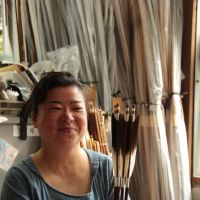
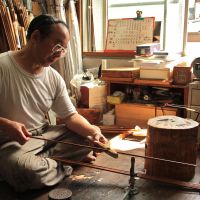
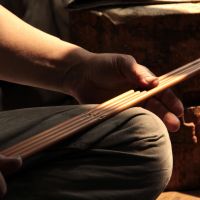
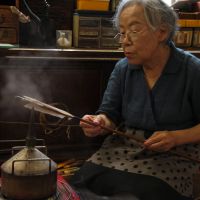
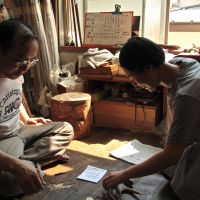














With your current subscription plan you can comment on stories. However, before writing your first comment, please create a display name in the Profile section of your subscriber account page.